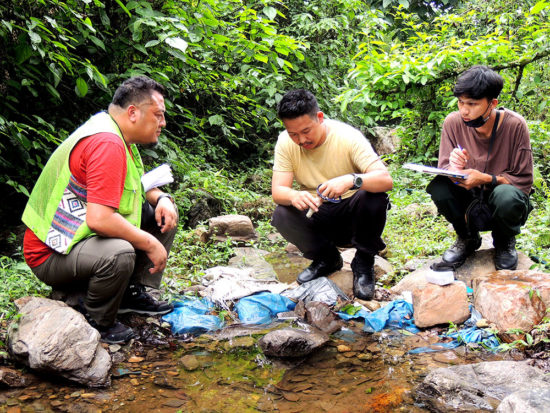Drying water sources across Bhutan is one of the critical challenges in meeting Bhutan’s national target of ensuring ‘24/7 access to safe drinking water’ by 2023.
Access to safe drinking water is interlinked with other national goals of public health and hygiene, and environmental management. A survey conducted by the Department of Forest and Park Services (DoFPS) as part of the Strategic Program for Climate Resilience preparatory project in 2019 found that 35% of the 6,555 water sources surveyed are drying up while 2% (147) were reported as ‘completely dried’. Similarly, a recent nationwide survey in 2021 by DoFPS again reported that 25.1% (1856) of 7399 water sources have already dried, while 69 (0.9%) were reported as ‘drying’.
A recent book published by the Tarayana Foundation titled ‘Springshed: Identifying
Recharge Areas of Drying Springs and Lakes with Water Quality in Southwestern
Bhutan’ authored by Jambay and Karma Uden further offers insights into the protection of Bhutan’s critical water drinking water sources. Through this article, the authors and a group of independent water researchers put forward new ideas for improving the management of drying water sources.

Drinking water sources in Bhutan are mainly springs (35%) and stream networks. A common strategy under current water source protection strategies in Bhutan includes fencing and enhancing vegetation cover at the discharge point – the location where the water starts flowing. Recently, interventions such as digging trenches upstream of the discharge point to increase groundwater recharge have also been implemented in a few places like Trashigang and Pemagatshel. For enhancing the effectiveness of such interventions, we propose the following recommendations based on our field experiences and the latest scientific research.
Changing interventions from discharge to recharge areas – The focus area for the management of water resources should begin by effectively managing the recharge areas. A recharge area refers to a geographical area where rainwater soaks through the ground to reach a groundwater reservoir. Management strategies should be targeted to maintain adequate water levels in these underground water reservoirs to ensure a continuous flow of streams and springs.
Mainstreaming protection of public drinking water supply areas – Critical water supply catchments could be demarcated as critical public drinking water supply areas with a similar status of protection of national parks, to limit development activities impacting the catchment. However, such demarcation should be based on adequate hydrogeological observations. The boundary demarcations for such public drinking water supply areas could then be made available for public use during development and planning. For example, an environmental clearance for any development could use such a database with an online portal to safeguard water sources from all kinds of risks.
Using adequate site-specific hydro-geological data – The plantation of trees cannot be considered a universal solution to reviving drying water sources across different Catchments because of he high variability in groundwater hydrogeology in mountainous regions like ours. Thus, relationship between vegetation cover and shallow groundwater reservoirs needs to be thoroughly investigated. In general, young vegetation may uptake more water than recharging, but mature vegetation would enhance water recharge. However, there are numerous site-specific hydrogeological factors and other physical environmental factors that significantly influence the dynamics of the relationship between vegetation and underground water reservoirs. Thus, it is critical to start gathering relevant data for calculating water balances at national levels. Such data collection could be incorporated with national forest inventory data collection which is conducted every few years. Otherwise, a one-time data collection from a few selected sites along the main river or stream channel such as conducted by National Environment Commission (National Water Resources Inventory 2018) is less valuable.
Reducing disturbance at the source – The minimal disruption to the water abstraction site is critical. Any heavy civil works such as the construction of water tanks or the cutting and planting of trees closer to water sources could sometimes be counterproductive in reviving the drying water sources. The large-scale disturbance near the sources could potentially alter the orientation of the lithology. Consequently, water flow paths may get altered resulting in the drying of the springs and lakes.
Creating data and knowledge repository – The strategy to collect long-term data on hydrology and geotechnical information is key for making an informed decision. A simple start could be to have a national repository of bore-logs from all groundwater explorations being carried out in many places across Bhutan. If those bore logs were generated according to standard scientific procedures, they should have detailed information on soil and hydrogeology on every meter of the hole dug into that area used for groundwater extraction. Analysis of bore logs data in coming years should be critical in the exploration and management of drinking water sources under similar hydrogeological locations across Bhutan.
Applying the concept of ‘springshed’ management – The majority of past scientific investigations in Bhutan in the field of water resource management have applied concept of watershed or river basin management to suit specific objectives.
However, in the case of exploring interventions to halt the drying of water sources, we advocate the application of the principles of ‘springshed’ management. Further, this new approach to springshed management provides a better understanding of the water flow paths as both geological formations of aquifers and springs are given equal importance. We believe the concept springshed management is particularly relevant in addressing drying water sources in Bhutan, as the incline rocks usually guide the water flow instead of horizontal bedrock formations.
The article is published based on personal experiences and observations by a group of water researchers from Bhutan. The group can be contacted at waterresearchbhutan@gmail.com


